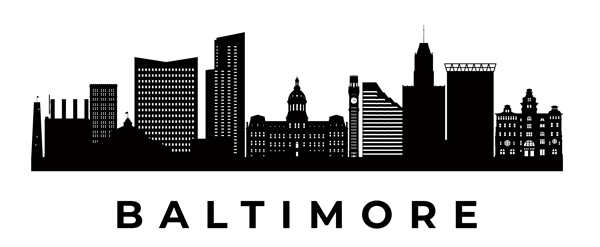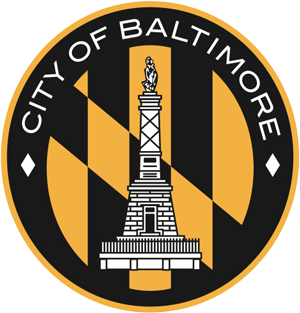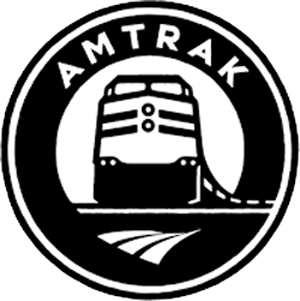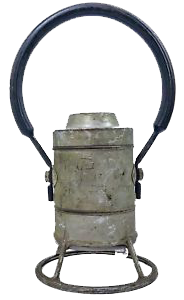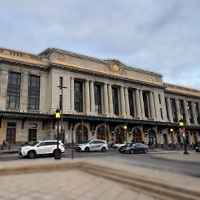 |
Amtrak Great Stations Baltimore, Maryland |
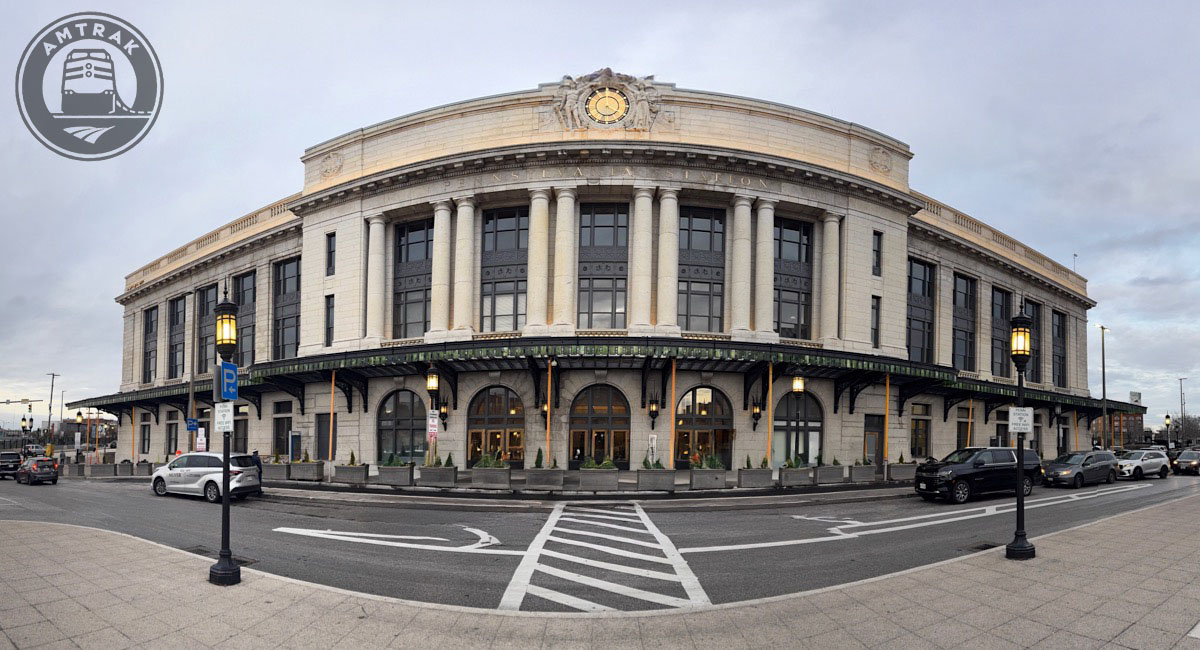
Baltimore, MD / Dec 2024 / RWH

Baltimore Penn Station
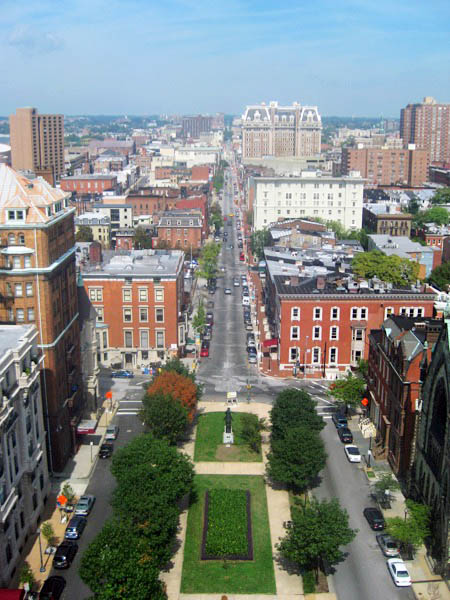
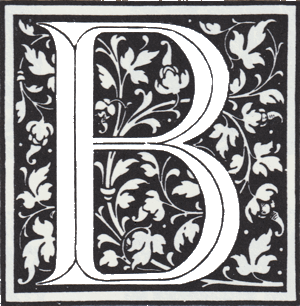 altimore’s Penn Station is located on a rise in the land between the busy Amtrak Northeast Corridor and the Jones Falls Expressway. North Charles Street, which runs along the station’s beautifully landscaped front plaza, leads downhill to distinctive areas such as the gracious Mount Vernon neighborhood, populated with celebrated cultural institutions including the Walters Art Museum and the Peabody Conservatory of Music; the central business district marked by skyscrapers; and the popular Inner Harbor, home to the National Aquarium, historic sailing ships, and a bevy of shops and restaurants with magnificent views of the waterfront.
altimore’s Penn Station is located on a rise in the land between the busy Amtrak Northeast Corridor and the Jones Falls Expressway. North Charles Street, which runs along the station’s beautifully landscaped front plaza, leads downhill to distinctive areas such as the gracious Mount Vernon neighborhood, populated with celebrated cultural institutions including the Walters Art Museum and the Peabody Conservatory of Music; the central business district marked by skyscrapers; and the popular Inner Harbor, home to the National Aquarium, historic sailing ships, and a bevy of shops and restaurants with magnificent views of the waterfront.
Completed in 1911 and dressed in the triumphant garb of Beaux-Arts classicism favored during the American Renaissance, the $1 million Pennsylvania Station emphasized Baltimore’s importance as a dominant rail hub and major East Coast metropolis. Throughout the 19th century, Baltimore used its location on the western edge of the Chesapeake Bay to establish links with emerging Midwestern markets whose goods were transported by road and rail to the city’s extensive docks. From there, they were shipped up and down the East Coast and around the world, and in the process, Baltimore fashioned itself into a major international port and Maryland’s largest city, holding sway over the state’s political, economic and cultural life.
 Considered the “cradle of American railroading,” Baltimore has a rich physical rail heritage that includes rights-of-way, tunnels and numerous stations in diverse architectural styles. Railroad infrastructure that is no longer in use has often been repurposed to serve new needs. For example, the Baltimore and Ohio Railroad’s (B&O) Camden warehouse was incorporated into Camden Yards, the home of the Baltimore Orioles baseball team. Near Penn Station, the B&O’s elegant Mount Royal Station was restored and internally reconfigured to house studio space for the prestigious Maryland Institute College of Art.
Considered the “cradle of American railroading,” Baltimore has a rich physical rail heritage that includes rights-of-way, tunnels and numerous stations in diverse architectural styles. Railroad infrastructure that is no longer in use has often been repurposed to serve new needs. For example, the Baltimore and Ohio Railroad’s (B&O) Camden warehouse was incorporated into Camden Yards, the home of the Baltimore Orioles baseball team. Near Penn Station, the B&O’s elegant Mount Royal Station was restored and internally reconfigured to house studio space for the prestigious Maryland Institute College of Art.
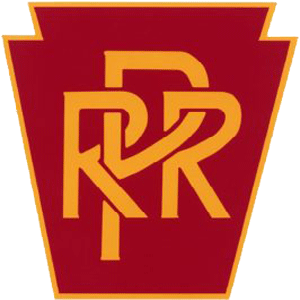 By the end of the 19th century, the B&O and the Pennsylvania Railroad (PRR) dominated rail transportation within the city. At the time, the PRR was not only regarded as one of the nation’s finest railroads but was also respected worldwide as an efficient and well-run corporation that set standards in the transportation industry. To enhance its reputation and fulfill local clamoring for a modern facility, the PRR financed the construction of a new Union Station to replace an older French Renaissance style brick structure that had been built during the Victorian era.
By the end of the 19th century, the B&O and the Pennsylvania Railroad (PRR) dominated rail transportation within the city. At the time, the PRR was not only regarded as one of the nation’s finest railroads but was also respected worldwide as an efficient and well-run corporation that set standards in the transportation industry. To enhance its reputation and fulfill local clamoring for a modern facility, the PRR financed the construction of a new Union Station to replace an older French Renaissance style brick structure that had been built during the Victorian era.
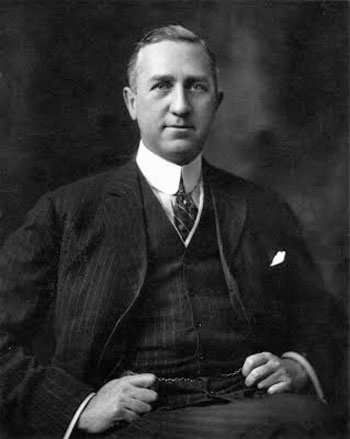 From among eight competing plans, railroad officials chose the design of Kenneth MacKenzie Murchison, a well-known New York architect who had trained at the famed École des Beaux-Arts in Paris. Over his career, Murchison became well regarded for his rail station designs, which also included the PRR station at Johnstown, Pa.; structures for the Delaware, Lackawanna and Western Railroad in Scranton and Hoboken; and Union Station in Havana, Cuba.
From among eight competing plans, railroad officials chose the design of Kenneth MacKenzie Murchison, a well-known New York architect who had trained at the famed École des Beaux-Arts in Paris. Over his career, Murchison became well regarded for his rail station designs, which also included the PRR station at Johnstown, Pa.; structures for the Delaware, Lackawanna and Western Railroad in Scranton and Hoboken; and Union Station in Havana, Cuba.
Under the Northeast Corridor Improvement Project, Baltimore Penn Station was renovated in 1983-84. In particular, the work focused on the station’s historic details, such as the skylight. Covered with blackout paint during World War II, the glass was revealed and refurbished. Repairs were also made to the terrazzo and mosaic flooring, glazed wall tile and marble detailing. Interior spaces were reorganized to provide better passenger movement, and important mechanical systems were upgraded. A decade later, the current plaza and below-ground parking garage were constructed in front of the station. At the center of the plaza is a 51-foot tall aluminum sculpture by artist Jonathan Borofsky. Named “Male/Female,” the piece depicts two intersecting human forms with a glowing heart.
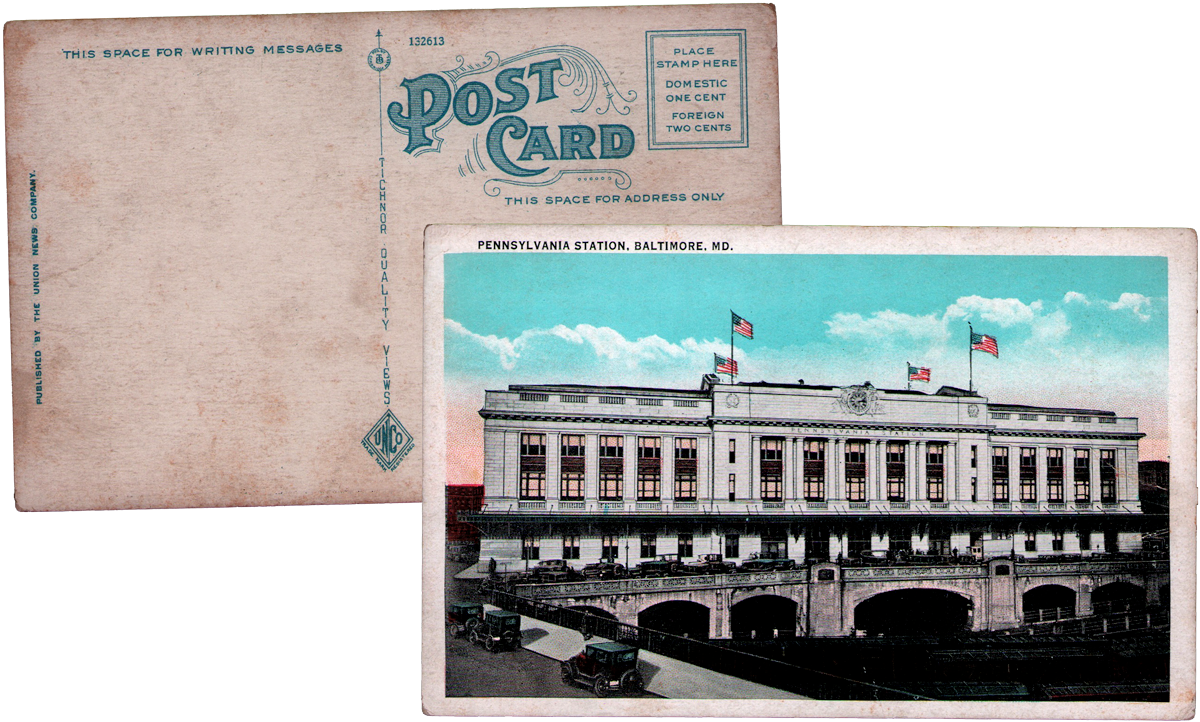
postcard / collection


Baltimore
- name:Baltimore Penn Station
- station code:BAL
- location: 1500 North Charles Street, Baltimore
- owner:Amtrak
- operators:Amtrak Northeast Corridor, MARC
- platforms:3 island platforms
- tracks:8 Amtrak and MARC, 1 light rail
- opened:1911
- style:Beaux-Arts
- architect:McKim, Mead & White; Kenneth MacKenzie Murchison
- rebuilt:1984
- Nat Reg Historic Places:1975
- notes:
- origianlly named Baltimore Union Station
- routes:
- Northeast Corridor | Cardinal | Carolinian | Crescent | Palmetto | Silver Service
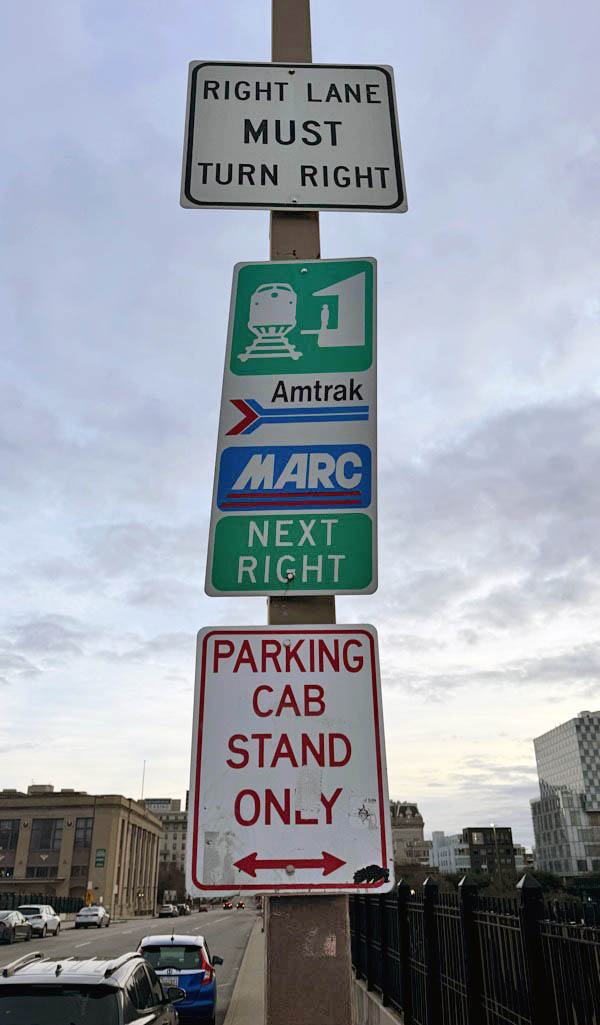
Dec 2024 / RWH
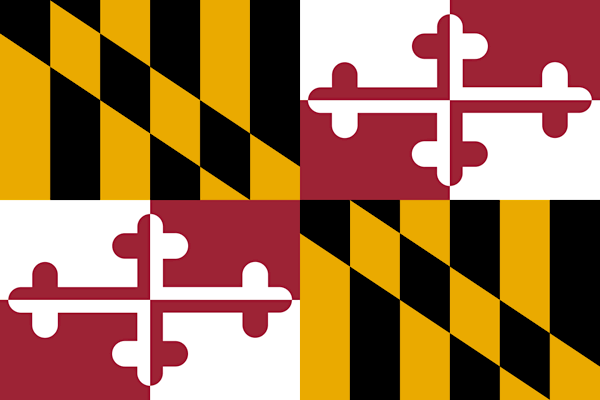
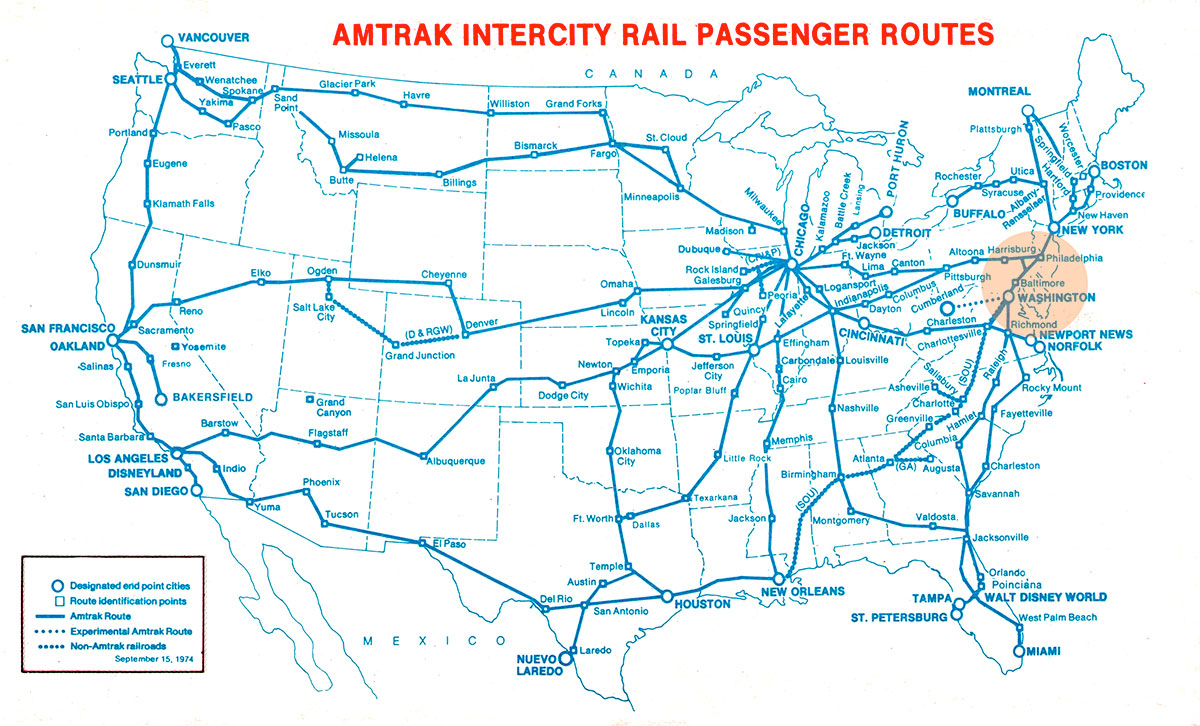
1974 Amtrak timetable map / collection
Exterior

Dec 2024 / RWH
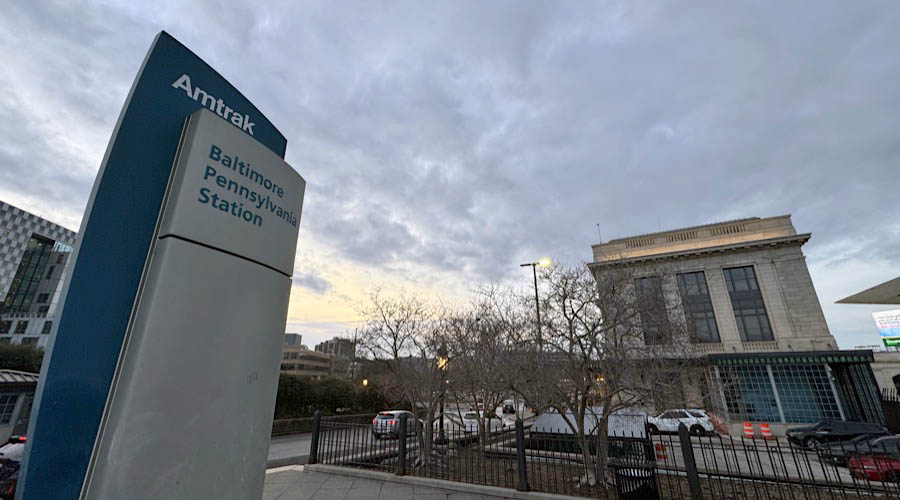
Baltimore, Md / Dec 2024 / RWH
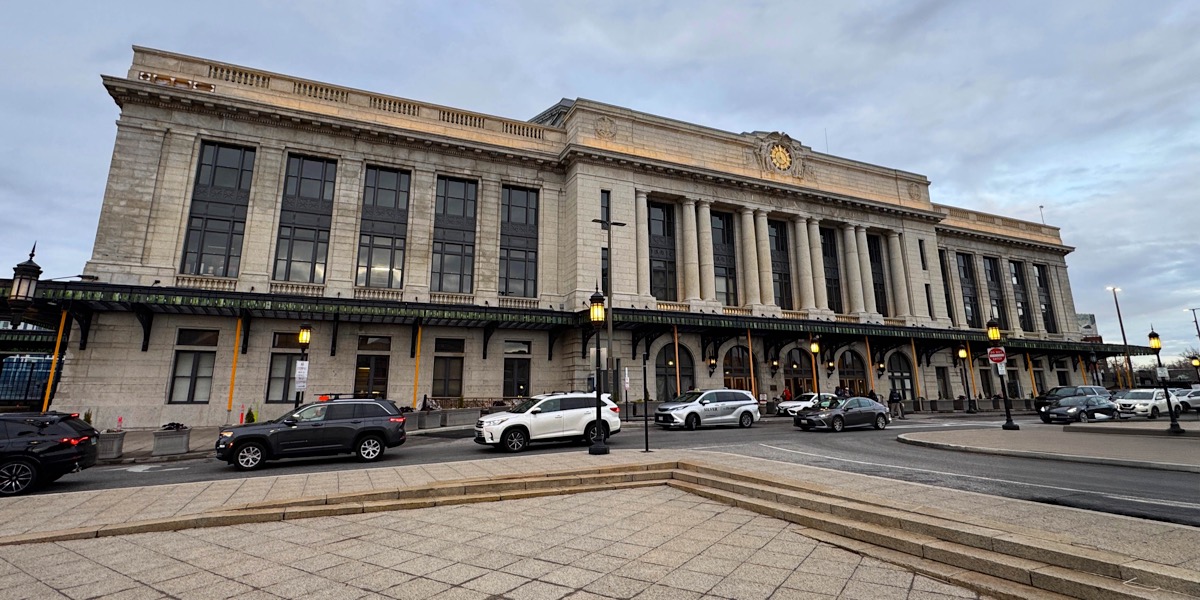
Baltimore, Md / Dec 2024 / RWH

Click to see Baltimore Penn Station plotted on a Google Maps page

Dec 2024 / RWH
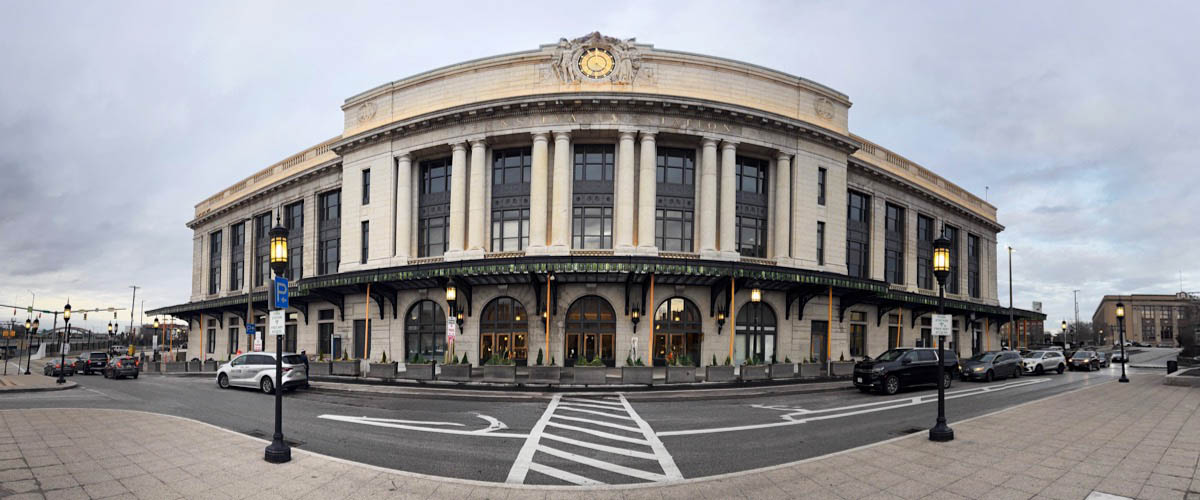
Baltimore, Md / Dec 2024 / RWH
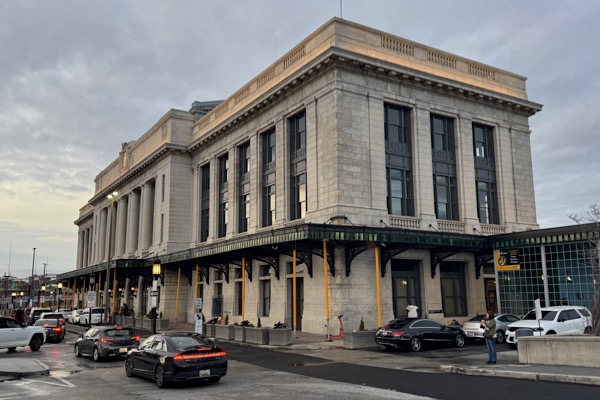
Baltimore, Md / Dec 2024 / RWH
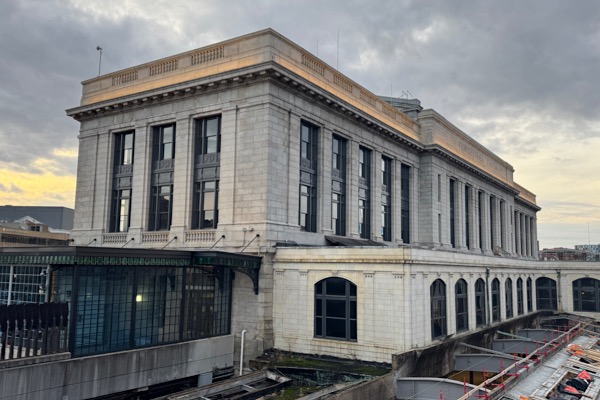
Baltimore, Md / Dec 2024 / RWH
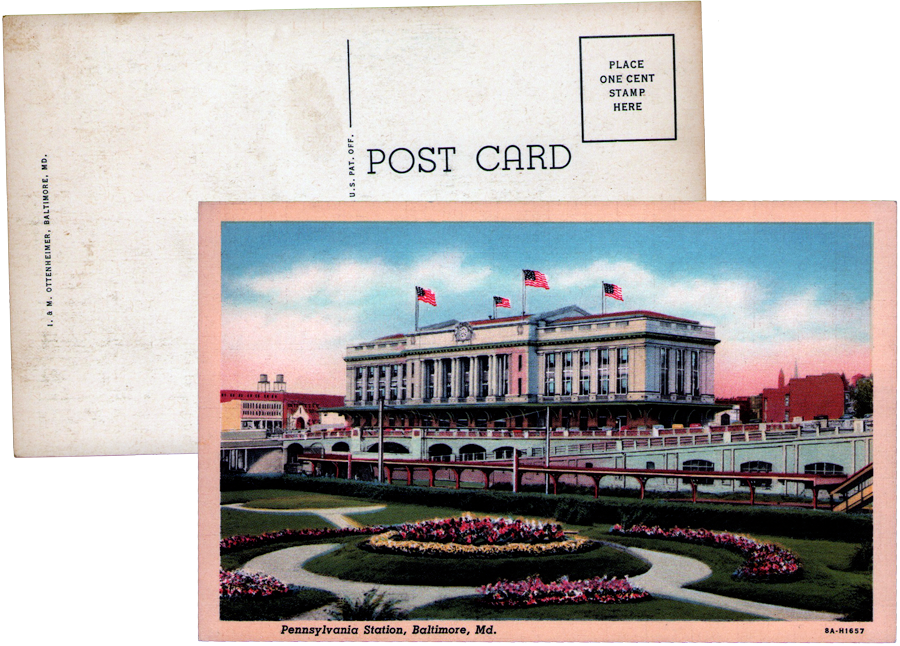
postcard / collection
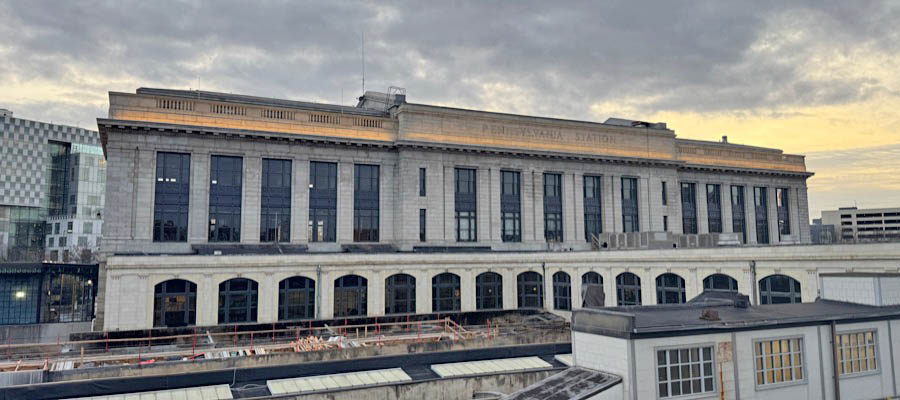
Baltimore, Md / Dec 2024 / RWH
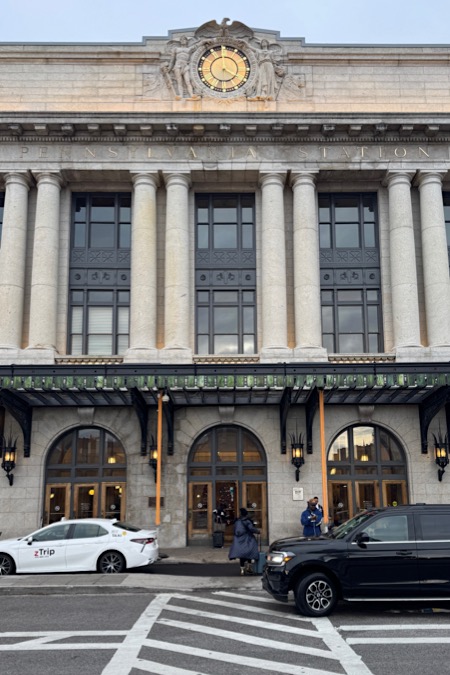
Dec 2024 / RWH
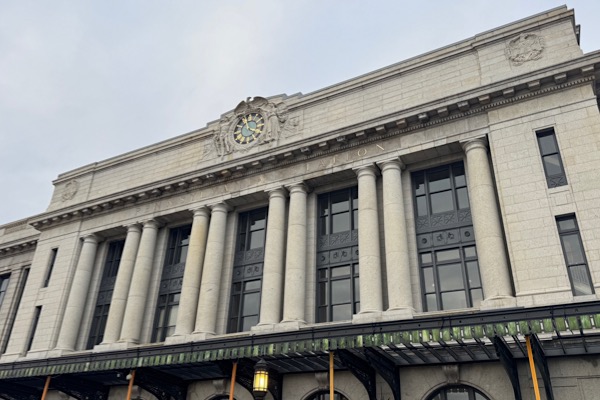
Dec 2024 / RWH
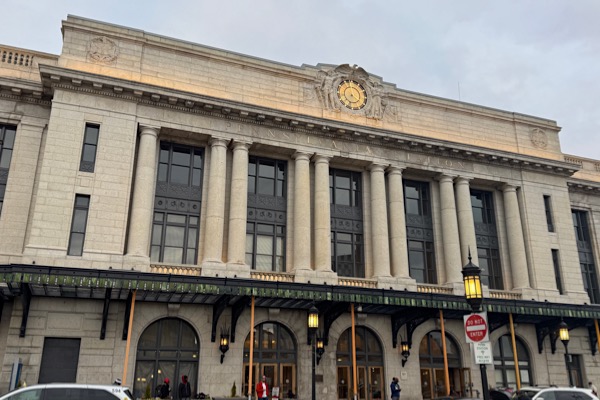
Dec 2024 / RWH

 t the base of the center block are five rounded-arch openings, and the three central ones are used as entryways with sets of triple doors. Passengers are sheltered from inclement weather by a canopy that runs across the façade. Edged by a skirt of variegated green glass, the canopy’s intricate cast iron work is best seen in the supporting brackets. The second and third stories of the center block are united by a giant order of paired Roman Doric columns spanning both floors, while the wings feature simplified pilasters. The columns and pilasters support an entablature with a deep and prominent cornice line that casts shadows onto the walls.
t the base of the center block are five rounded-arch openings, and the three central ones are used as entryways with sets of triple doors. Passengers are sheltered from inclement weather by a canopy that runs across the façade. Edged by a skirt of variegated green glass, the canopy’s intricate cast iron work is best seen in the supporting brackets. The second and third stories of the center block are united by a giant order of paired Roman Doric columns spanning both floors, while the wings feature simplified pilasters. The columns and pilasters support an entablature with a deep and prominent cornice line that casts shadows onto the walls.
A parapet on the center block hides the fourth floor while creating a canvas for rich sculptural ornament, particularly around the large central clock face. Embellished with gilded Roman numerals, it is encircled by egg and dart molding born by a pair of human figures set amid swirling bands of cloth. The male holds a hammer while the female grasps a wheel, both items representative of the functioning of the railroad. The entire composition is surmounted by an eagle whose outspread wings, with their fine, detailed feathers, show the stone carver’s art.
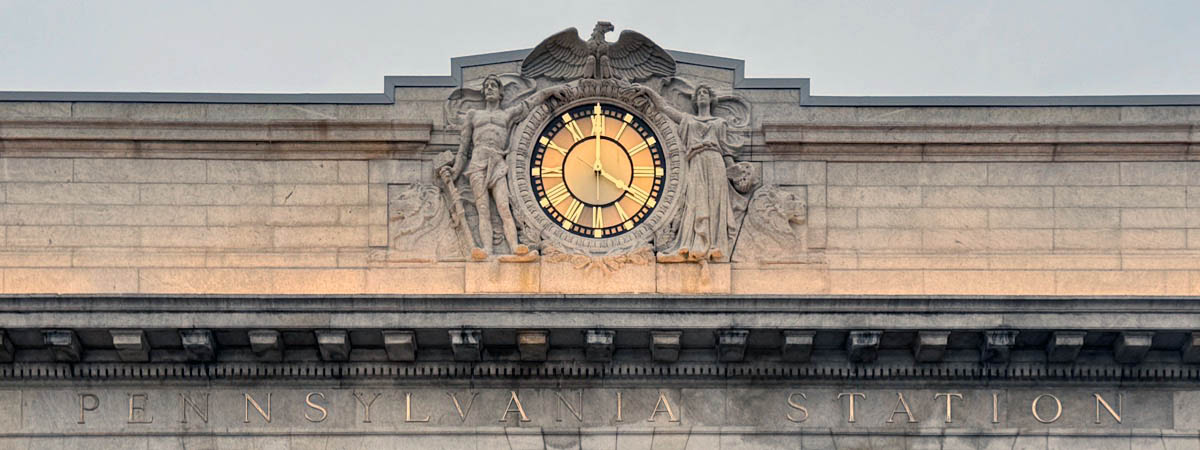
Baltimore, Md / Dec 2024 / RWH
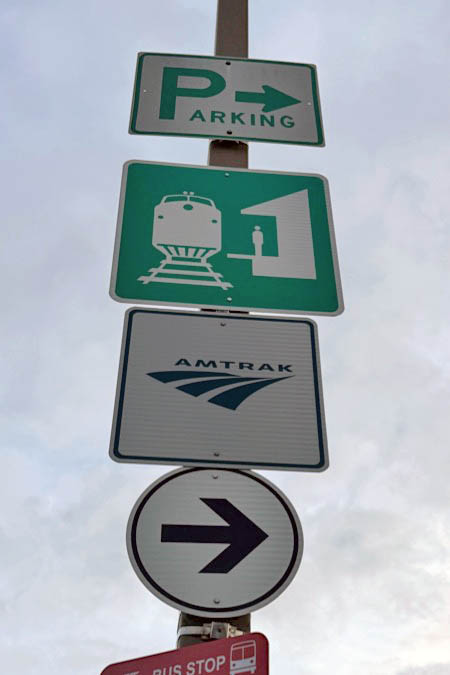
Dec 2024 / RWH
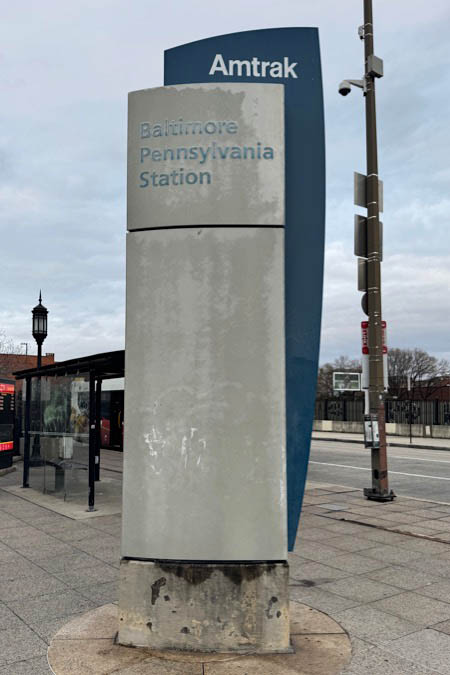
Dec 2024 / RWH
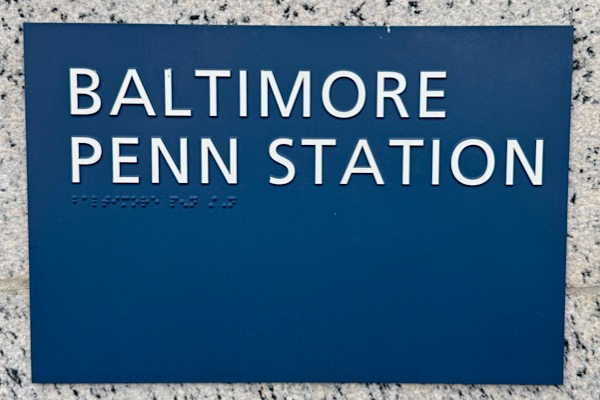
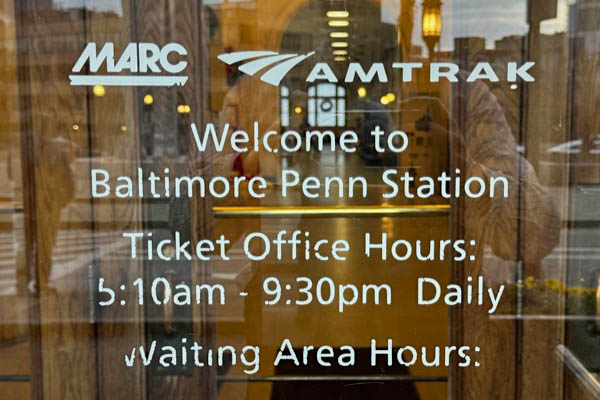
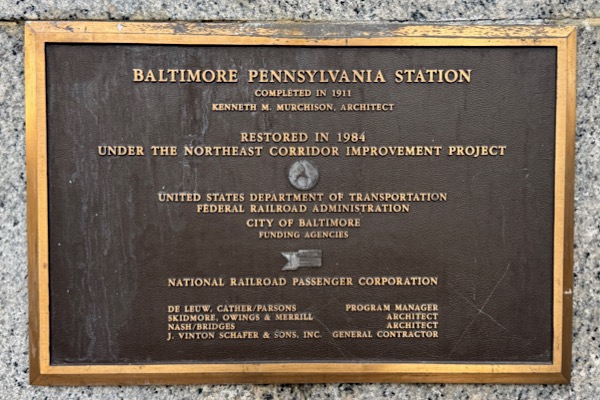
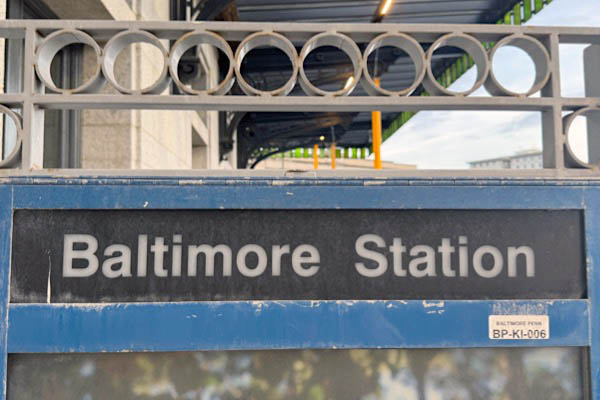
Dec 2024 / RWH
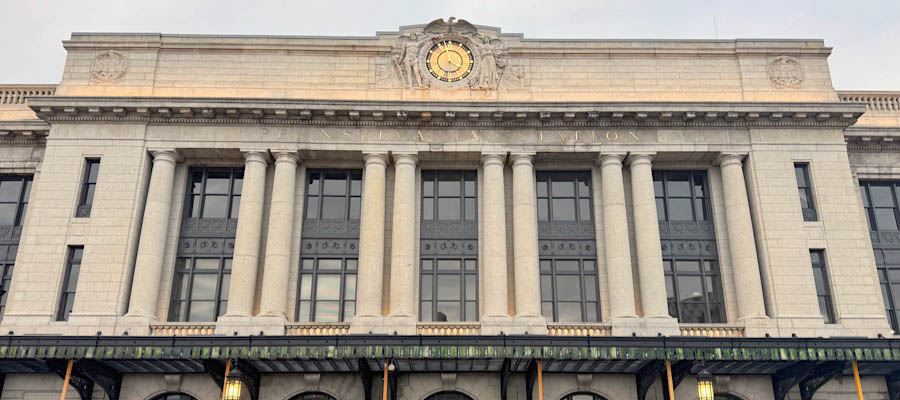
Baltimore, Md / Dec 2024 / RWH
 Baltimore, MD
Baltimore, MD
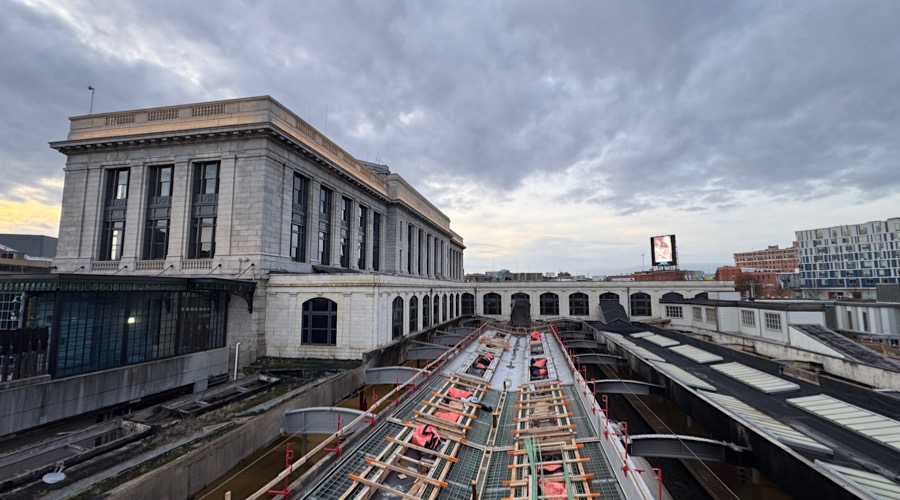
Baltimore, Md / Dec 2024 / RWH
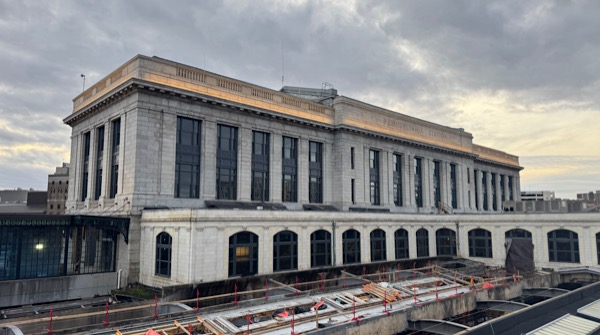
Baltimore, Md / Dec 2024 / RWH
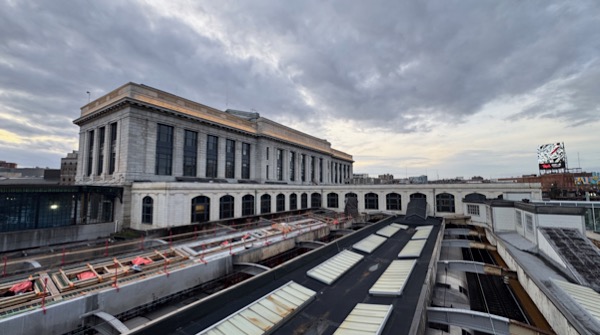
Baltimore, Md / Dec 2024 / RWH
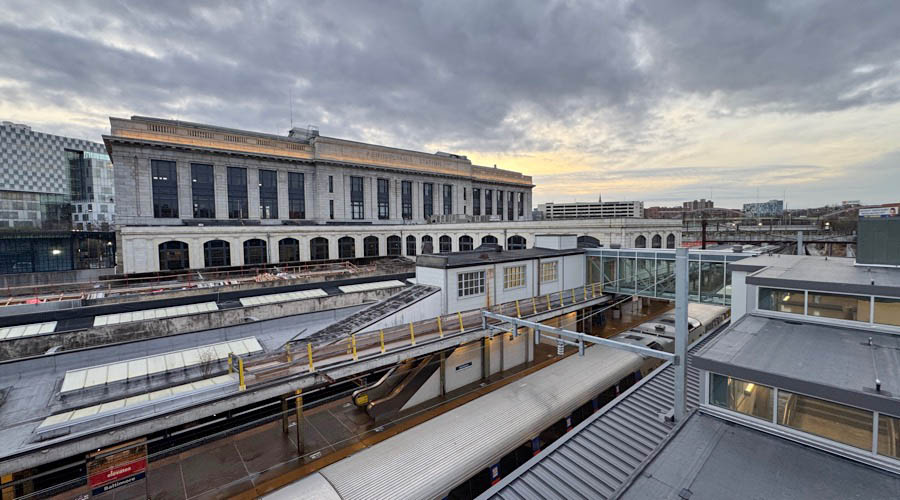
Baltimore, Md / Dec 2024 / RWH
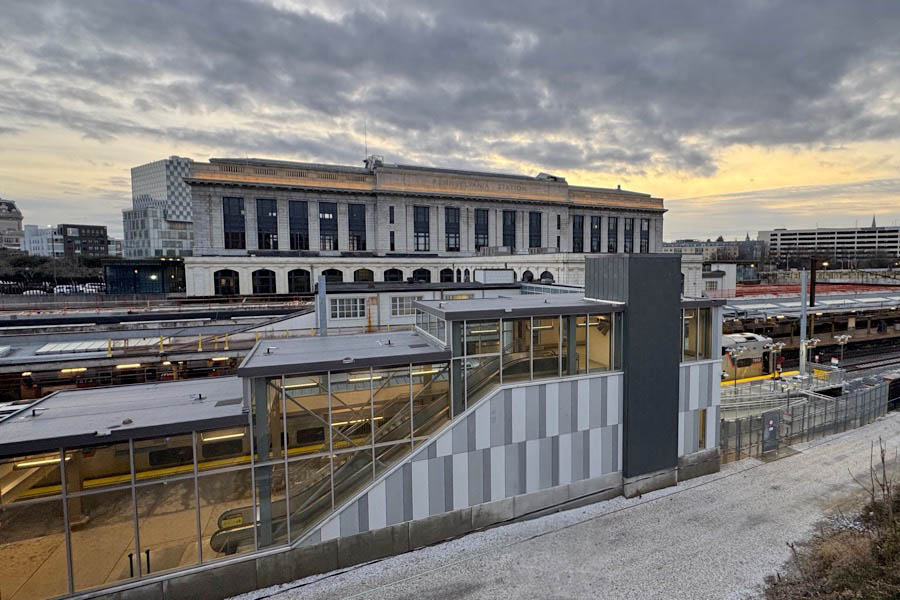
Baltimore, Md / Dec 2024 / RWH
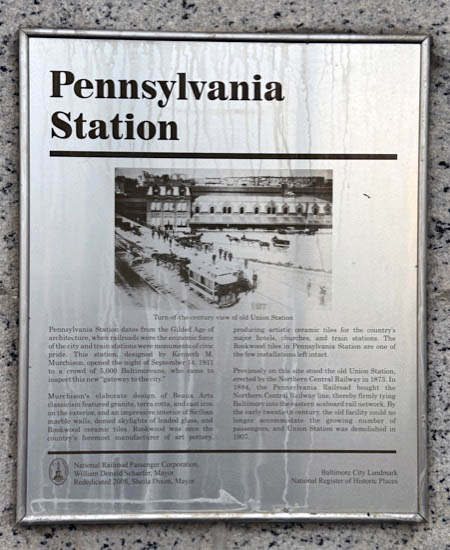
Dec 2024 / RWH
 Public Art
Public Art
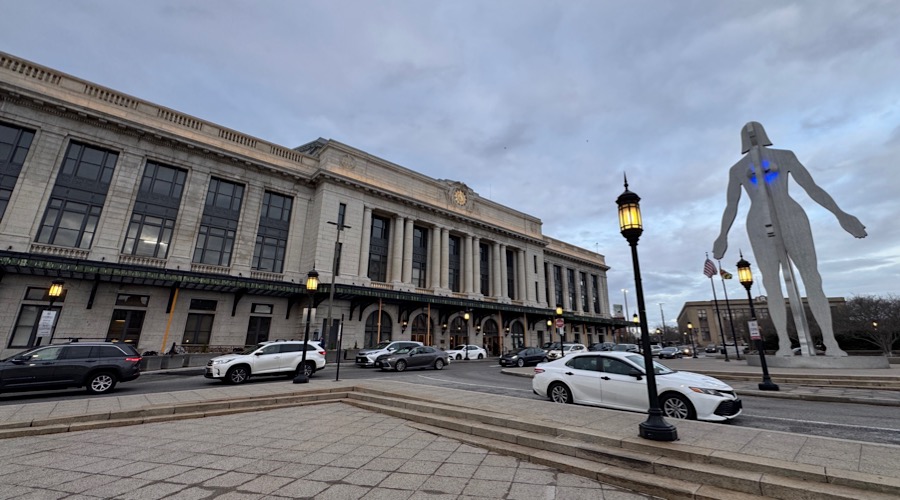
Baltimore, Md / Dec 2024 / RWH
In 2004, the Municipal Art Society of Baltimore commissioned Jonathan Borofsky to create his 51-foot Male/Female aluminum sculpture as the centerpiece of a re-designed plaza in front of Penn Station to celebrate its 100th anniversary. The sculpture was a gift to the city from the Society.
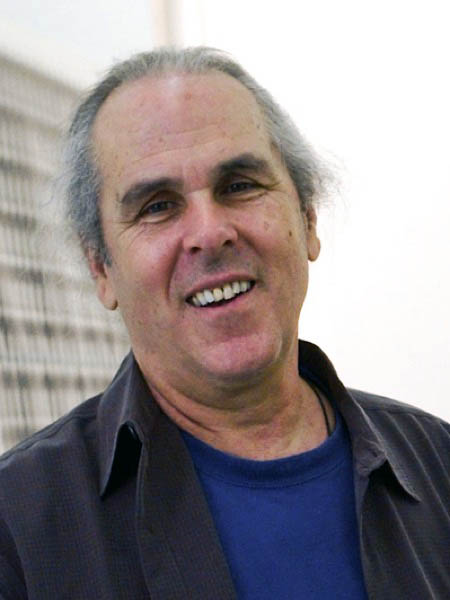
web
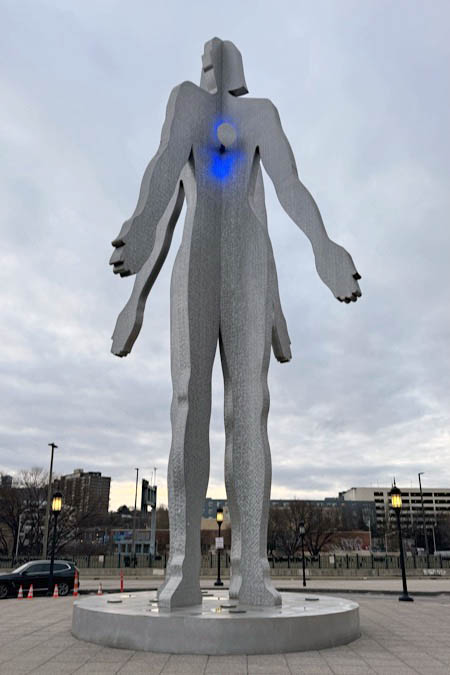
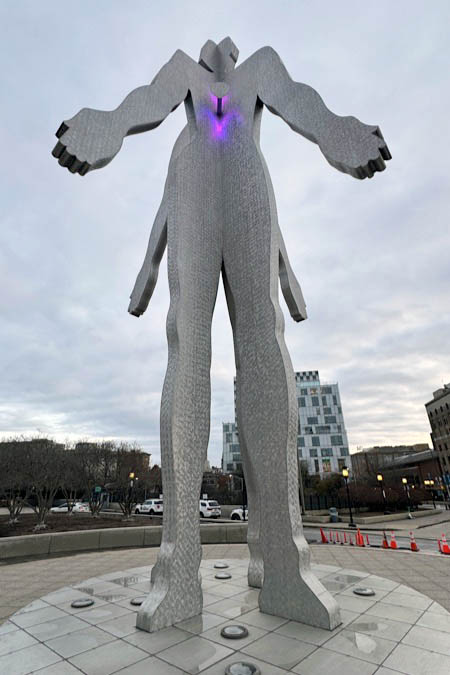
Baltimore, Md / Dec 2024 / RWH
Interior
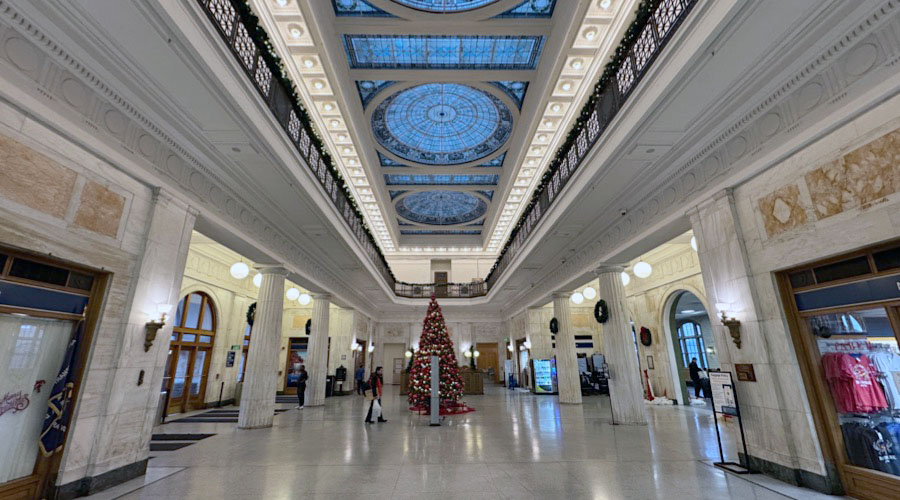
Dec 2024 / RWH

 he architect, Kenneth Mackenzie Murchison, had extensive experience creating railroad stations around the nation and brought a stylish Beaux-Arts style to the job. Murchison’s design incorporated an innovative waiting area illuminated by three large domed skylights directly connected to the boarding platforms. The Pennsylvania Railway Company took over the station in the 1920s and renamed it Pennsylvania Station to match the other Penn Stations along the line.
he architect, Kenneth Mackenzie Murchison, had extensive experience creating railroad stations around the nation and brought a stylish Beaux-Arts style to the job. Murchison’s design incorporated an innovative waiting area illuminated by three large domed skylights directly connected to the boarding platforms. The Pennsylvania Railway Company took over the station in the 1920s and renamed it Pennsylvania Station to match the other Penn Stations along the line.
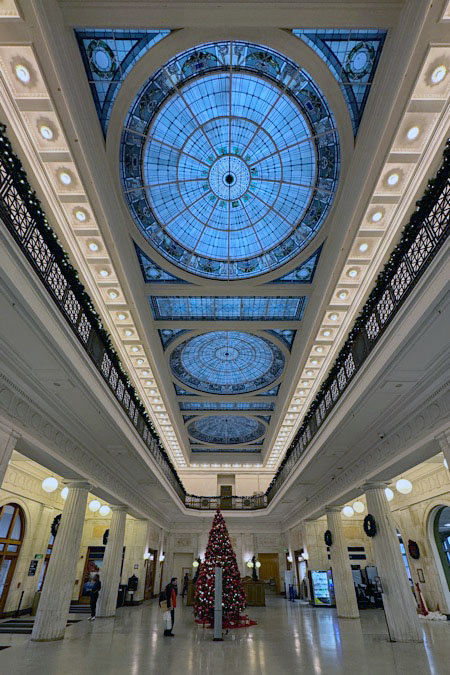
Dec 2024 / RWH
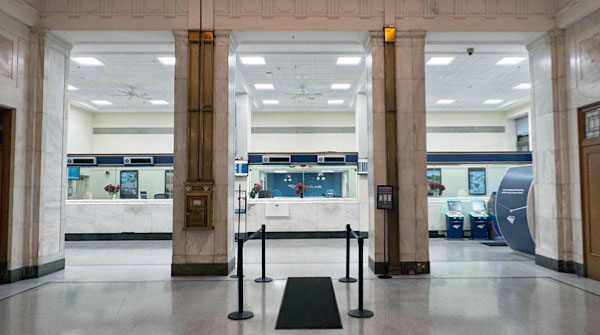
Dec 2024 / RWH
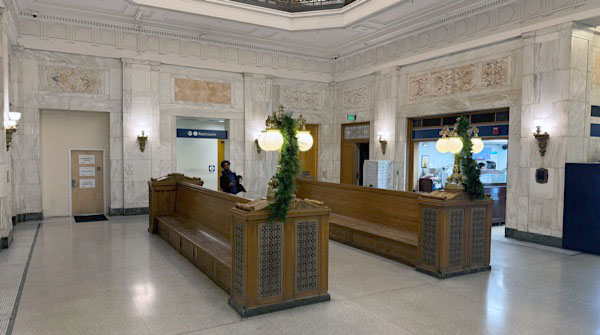
Dec 2024 / RWH
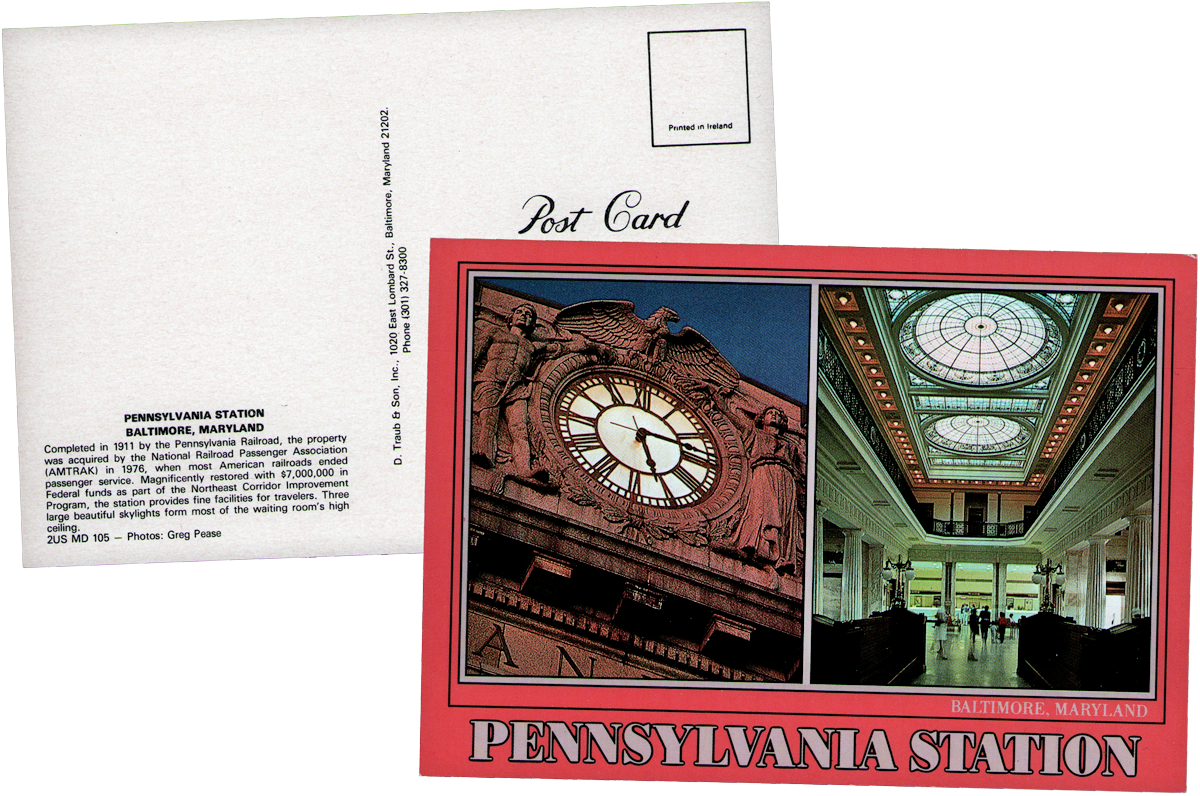
postcard / collection
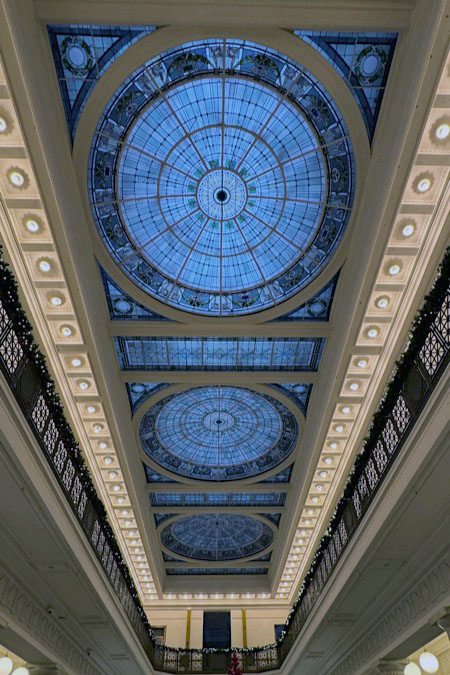
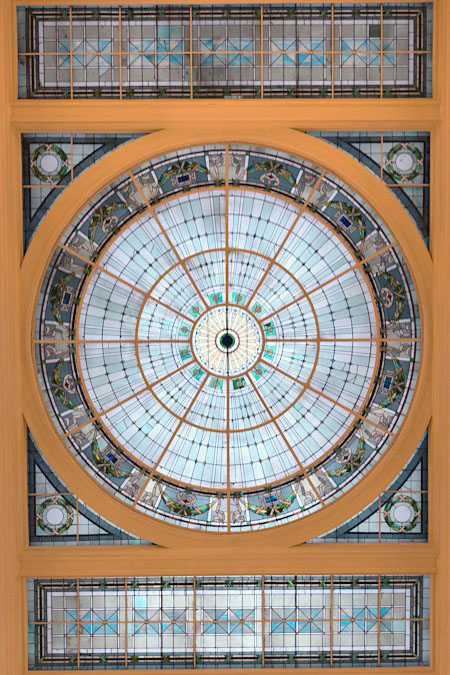
Dec 2024 / RWH
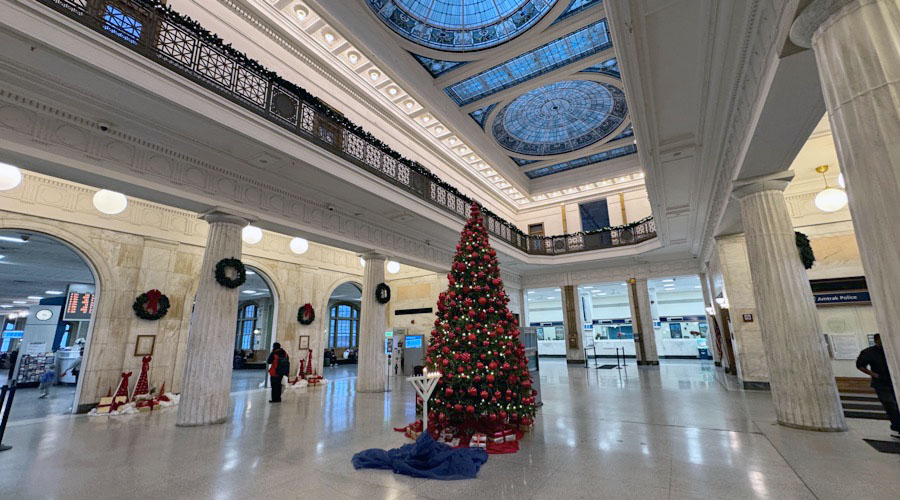
Dec 2024 / RWH
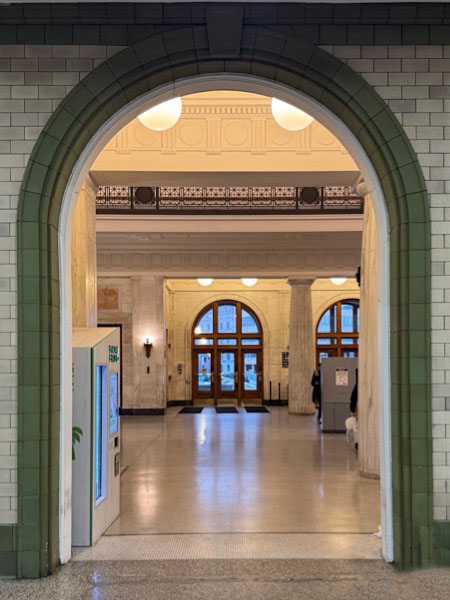
Dec 2024 / RWH

 ennsylvania Station represents the peak of railroad development in Baltimore. The station was more than a gateway to the city. Like the Gothic cathedral, it was a symbol of local pride and defined the economic position of Baltimore in the early 20th century. The city of Baltimore is famous for its involvement with the history of the development of the railroad, and as one of the city’s most prominent stations, Pennsylvania Station plays an important role in that history.
ennsylvania Station represents the peak of railroad development in Baltimore. The station was more than a gateway to the city. Like the Gothic cathedral, it was a symbol of local pride and defined the economic position of Baltimore in the early 20th century. The city of Baltimore is famous for its involvement with the history of the development of the railroad, and as one of the city’s most prominent stations, Pennsylvania Station plays an important role in that history.

Dec 2024 / RWH
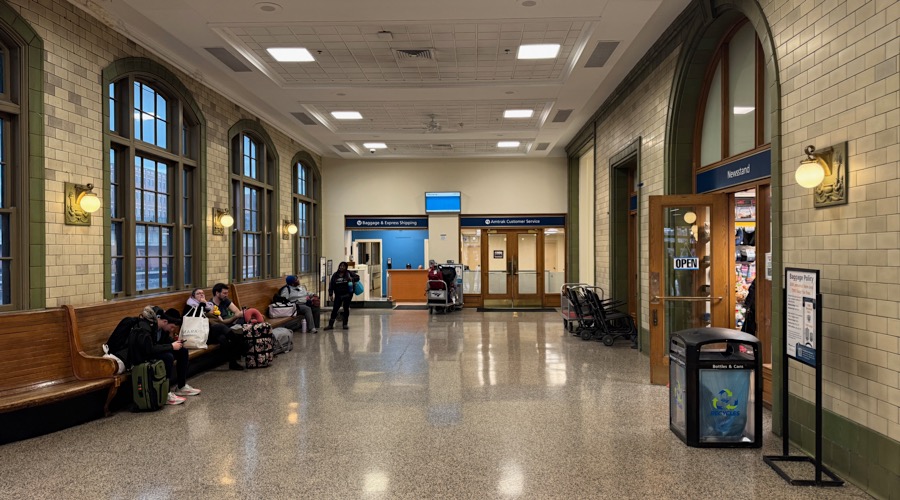
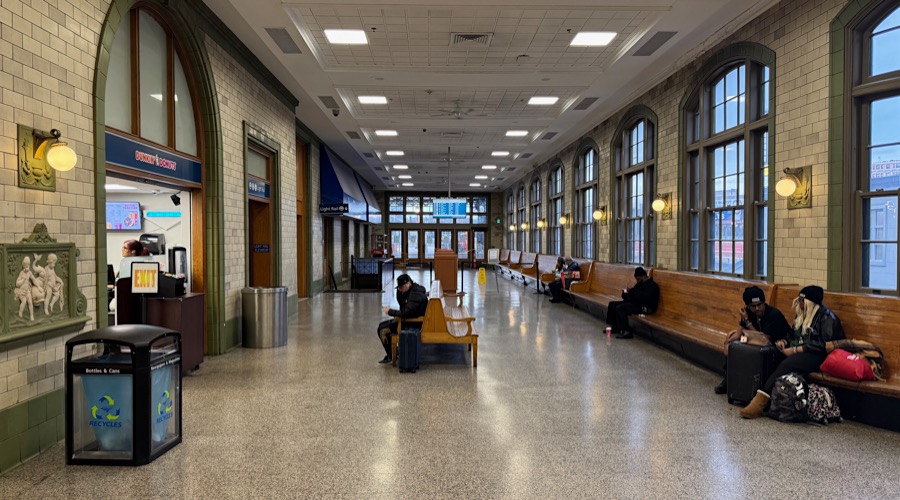
Dec 2024 / RWH
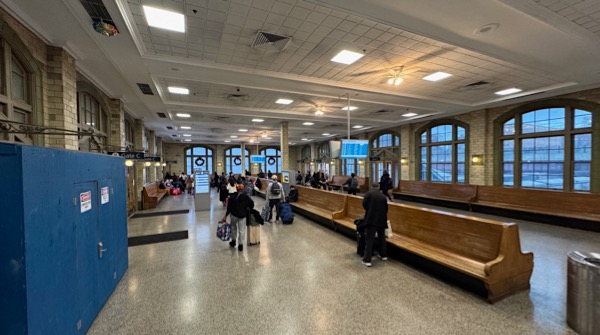
Dec 2024 / RWH
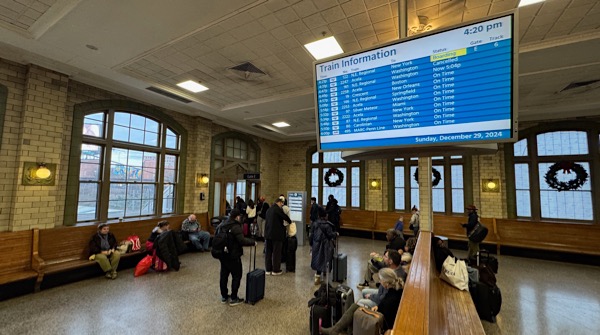
Dec 2024 / RWH
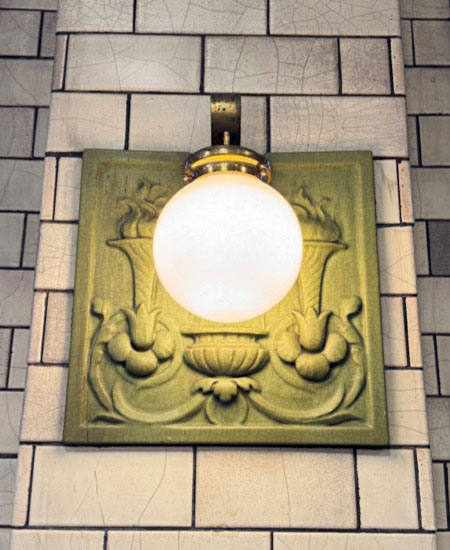
Dec 2024 / RWH
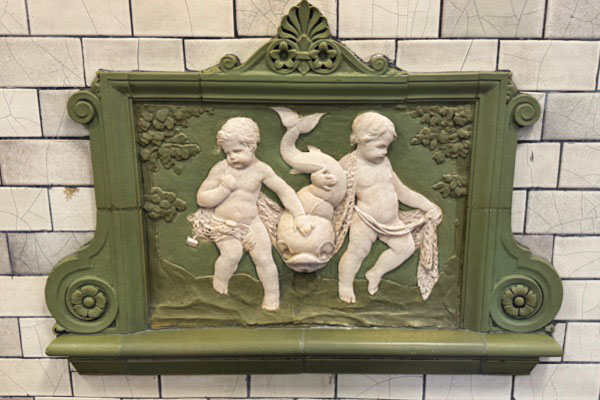
Dec 2024 / RWH
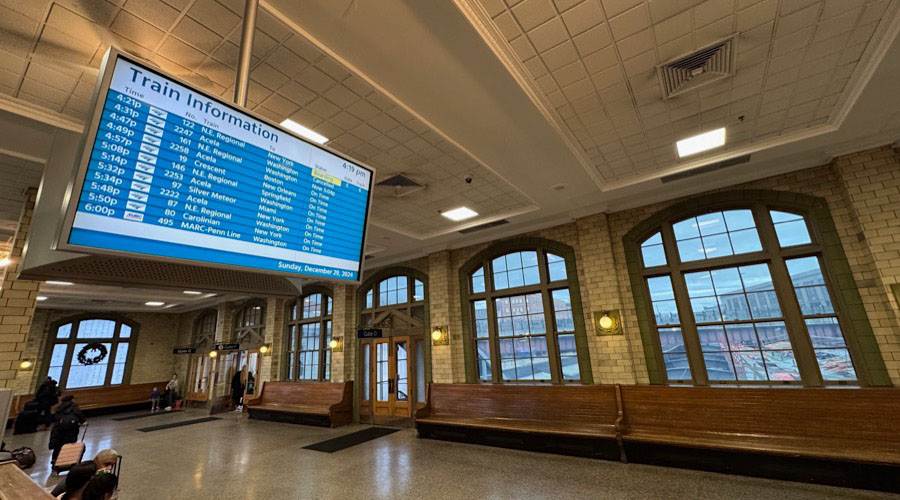
Dec 2024 / RWH
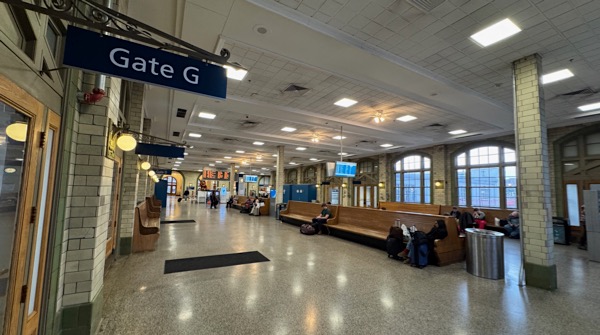
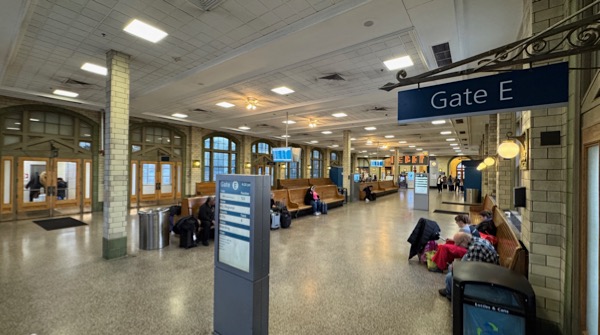
Dec 2024 / RWH
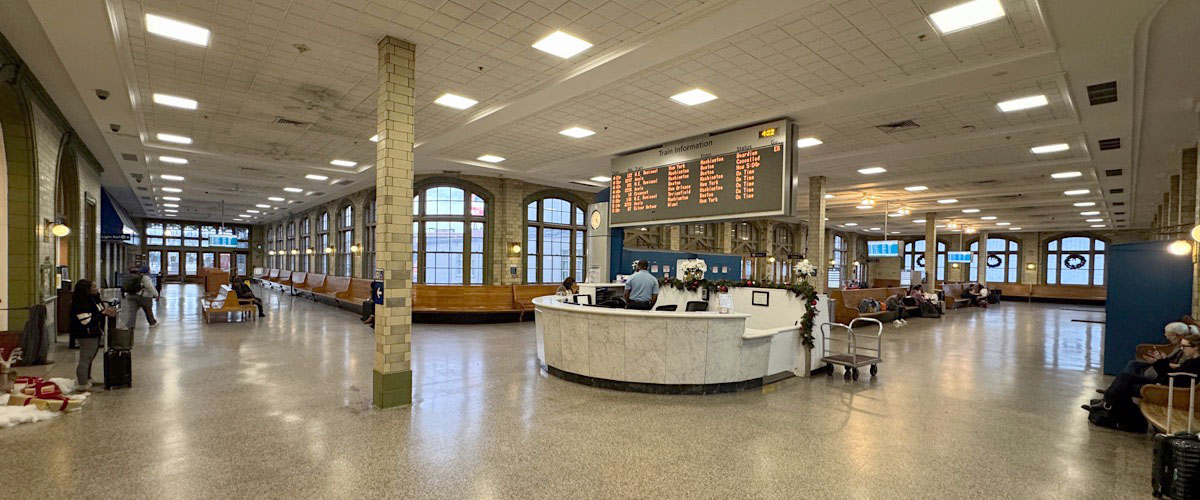
Dec 2024 / RWH
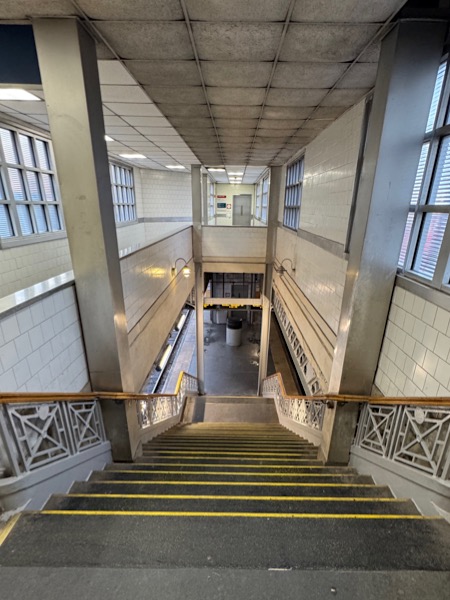
Dec 2024 / RWH
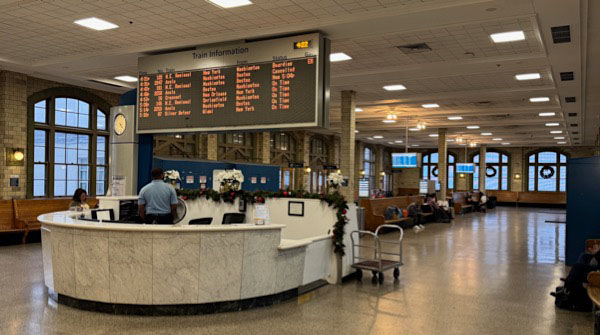
Dec 2024 / RWH
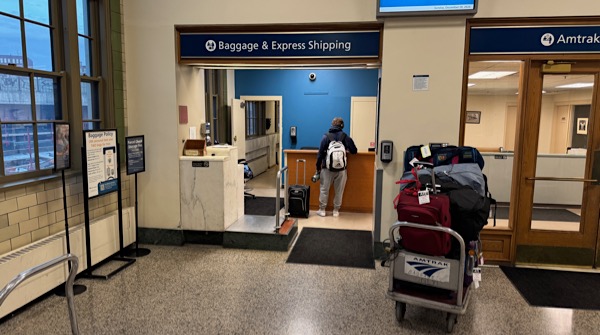
Dec 2024 / RWH
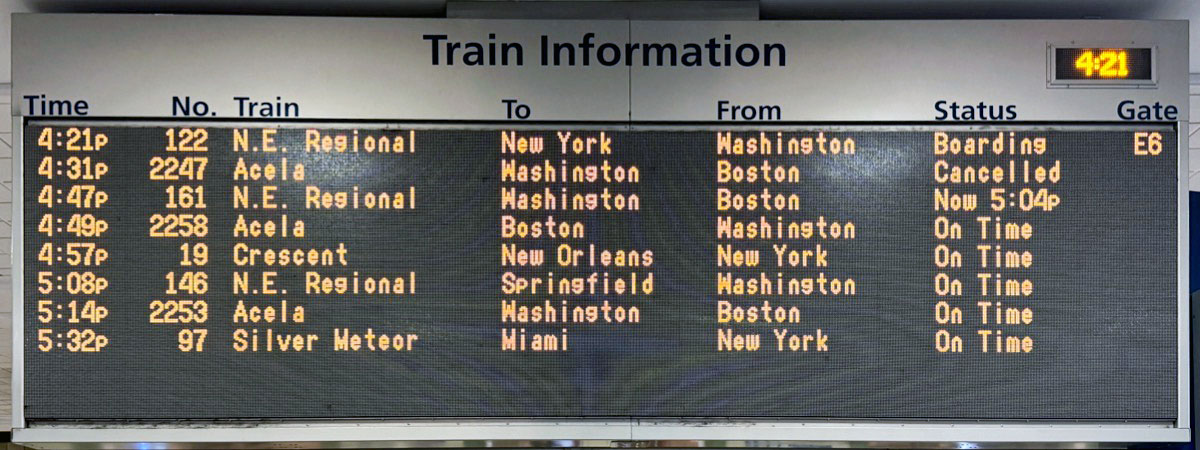
Dec 2024 / RWH
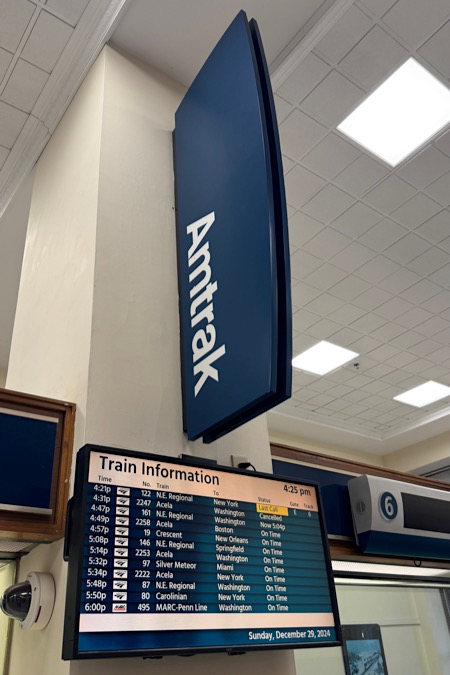
Dec 2024 / RWH
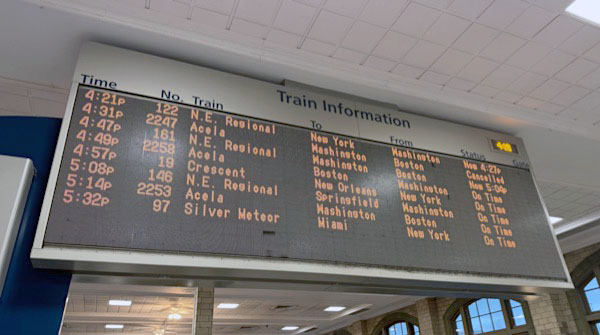
Dec 2024 / RWH
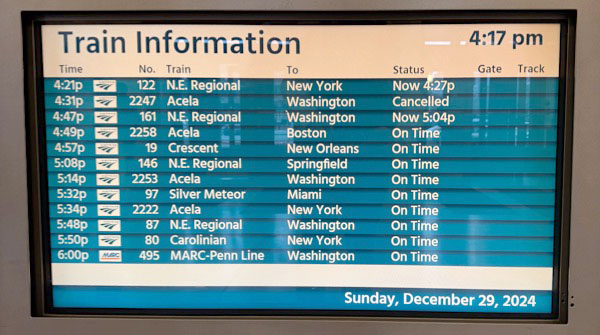
Dec 2024 / RWH
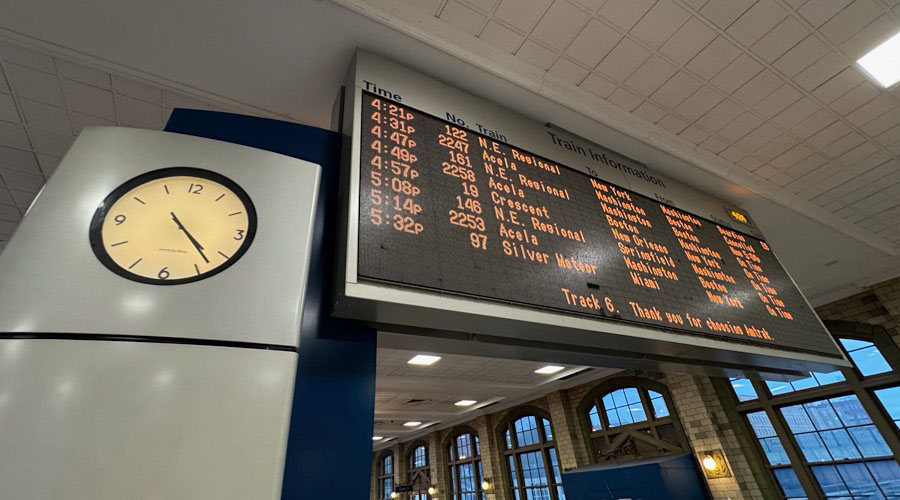
Dec 2024 / RWH
 Museum Model
Museum Model

Dec 2024 / RWH
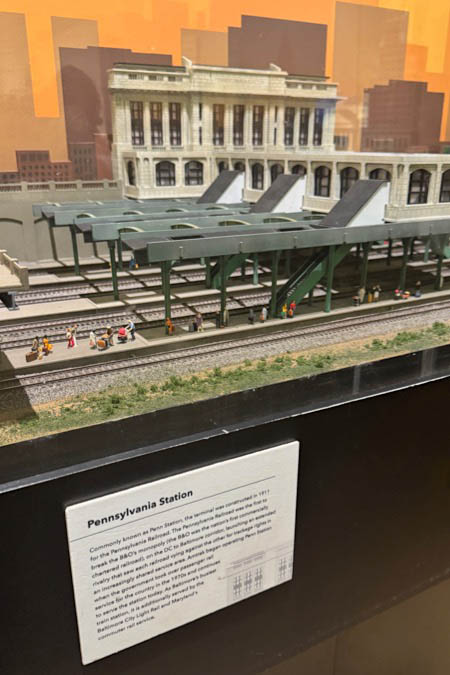
Dec 2024 / RWH
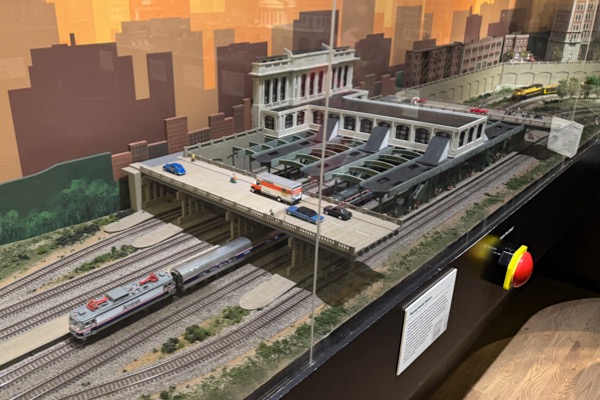
Dec 2024 / RWH
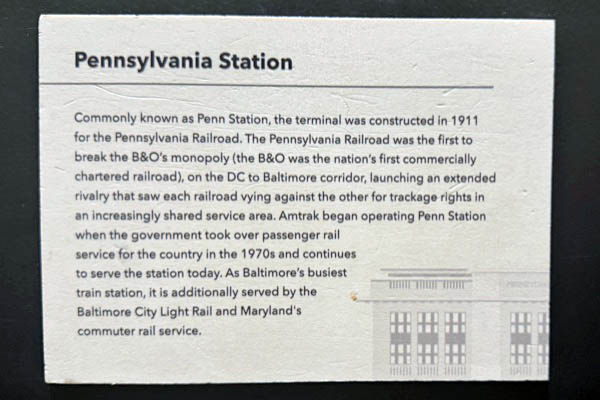
Dec 2024 / RWH

See also our complete Baltimore & Ohio Railroad Museum featured scrapbook in Preservation
 Lagniappe
Lagniappe
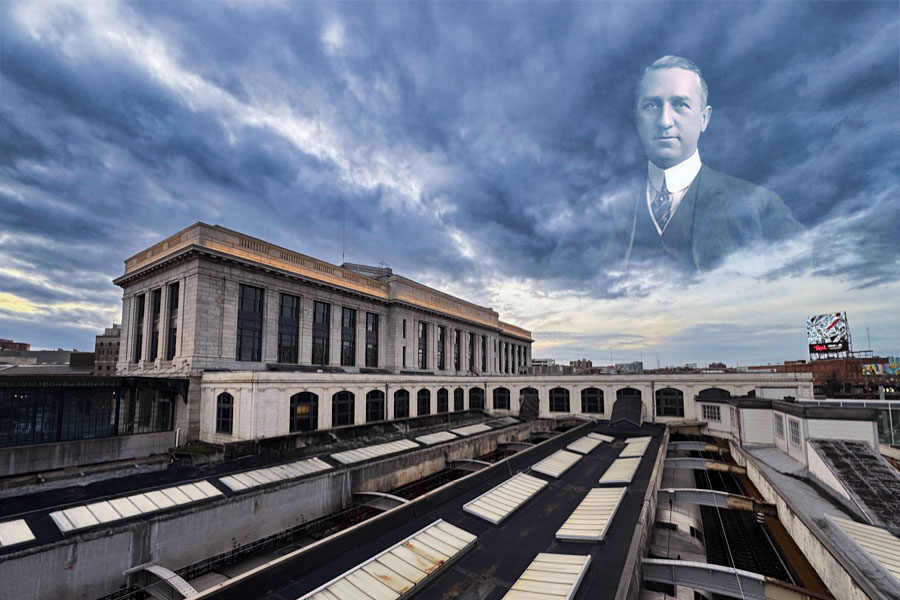
Mister Murchison's Marble Masterpiece
Dec 2024 / image and artwork RWH
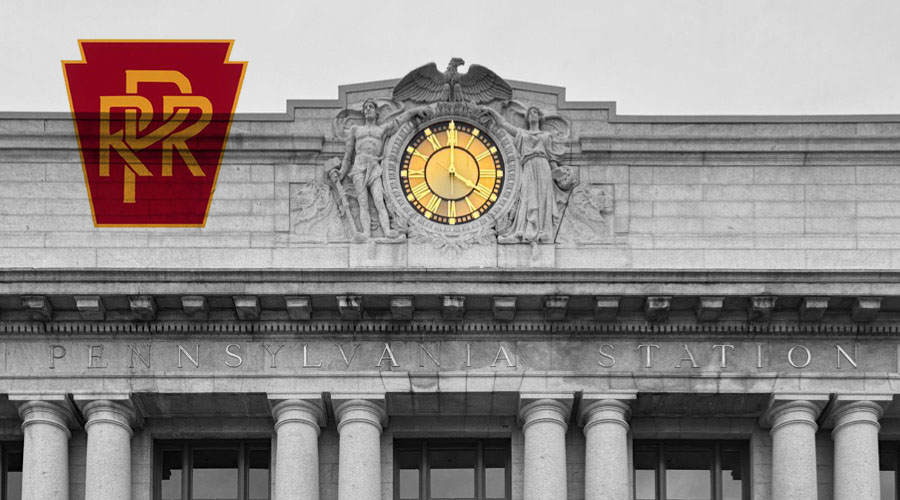
The Standard Stations of the World
Dec 2024 / image and artwork RWH
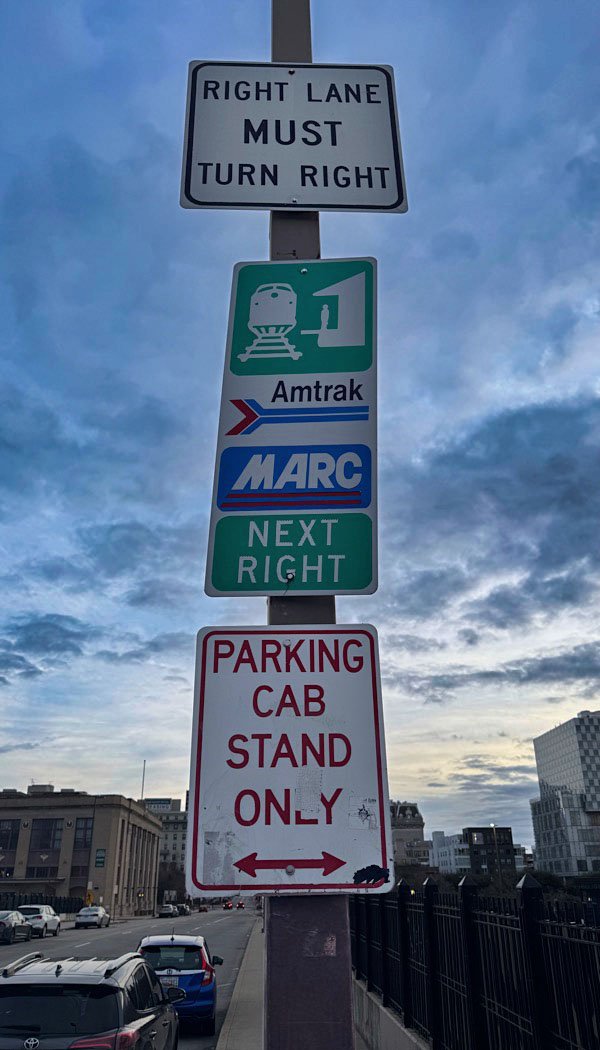
You Must Turn Right
Dec 2024 / RWH
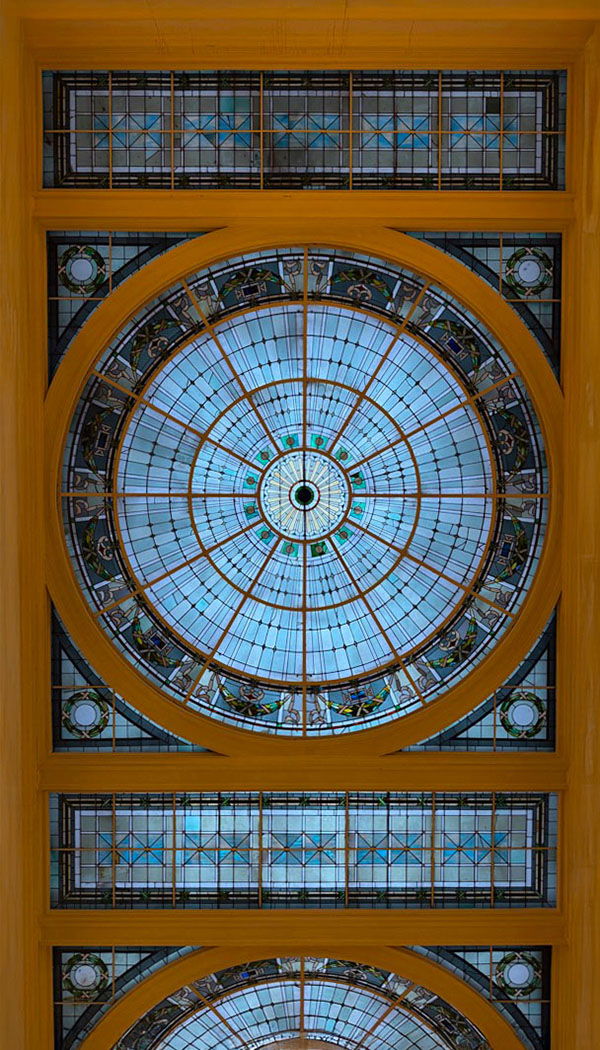
In Praise of Beaux-Arts
Dec 2024 / RWH
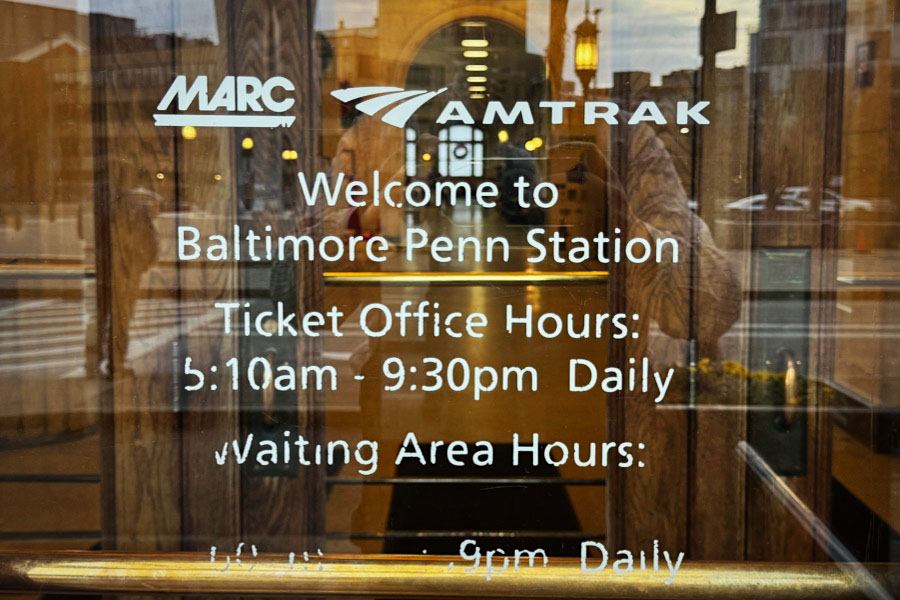
Penn Station Periphial
Baltimore, Md / Dec 2024 / RWH
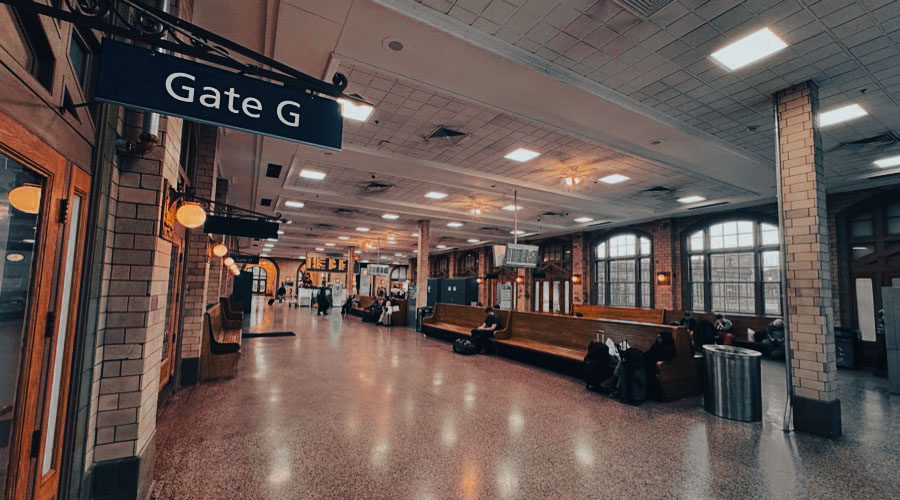
Brought to You by the Letter 'G'
Baltimore, Md / Dec 2024 / RWH
Links / Sources
- Wikipedia article for Baltimore Penn Station
- Great American Stations Baltimore page
- Marland Historic Trust Penn Station page
- Baltimore Heritage Penn Station page
